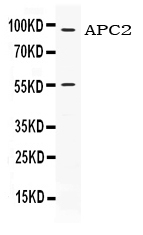Anti-APC2 Picoband Antibody
- SPECIFICATION
- CITATIONS
- PROTOCOLS
- BACKGROUND

Application
| WB |
|---|---|
| Primary Accession | O95996 |
| Host | Rabbit |
| Reactivity | Human |
| Clonality | Polyclonal |
| Format | Lyophilized |
| Description | Rabbit IgG polyclonal antibody for Adenomatous polyposis coli protein 2(APC2) detection. Tested with WB in Human. |
| Reconstitution | Add 0.2ml of distilled water will yield a concentration of 500ug/ml. |
| Gene ID | 10297 |
|---|---|
| Other Names | Adenomatous polyposis coli protein 2, Adenomatous polyposis coli protein-like, APC-like, APC2, APCL |
| Calculated MW | 243949 MW KDa |
| Application Details | Western blot, 0.1-0.5 µg/ml, Human |
| Subcellular Localization | Cytoplasm, cytoskeleton . Golgi apparatus . Cytoplasm . Cytoplasm, perinuclear region . Associated with actin filaments (PubMed:11691822). Associated with microtubule network (PubMed:10644998, PubMed:11691822). . |
| Tissue Specificity | Widely expressed (at protein level). Specifically expressed in the CNS. . |
| Protein Name | Adenomatous polyposis coli protein 2 |
| Contents | Each vial contains 5mg BSA, 0.9mg NaCl, 0.2mg Na2HPO4, 0.05mg NaN3. |
| Immunogen | A synthetic peptide corresponding to a sequence at the N-terminus of human APC2 (51-90aa KHLQGKLEQEARVLVSSGQTEVLEQLKALQMDITSLYNLK), different from the related mouse sequence by two amino acids. |
| Purification | Immunogen affinity purified. |
| Cross Reactivity | No cross reactivity with other proteins. |
| Storage | At -20˚C for one year. After r˚Constitution, at 4˚C for one month. It˚Can also be aliquotted and stored frozen at -20˚C for a longer time.Avoid repeated freezing and thawing. |
| Name | APC2 (HGNC:24036) |
|---|---|
| Synonyms | APCL |
| Function | Stabilizes microtubules and may regulate actin fiber dynamics through the activation of Rho family GTPases (PubMed:25753423). May also function in Wnt signaling by promoting the rapid degradation of CTNNB1 (PubMed:10021369, PubMed:11691822, PubMed:9823329). |
| Cellular Location | Cytoplasm, cytoskeleton. Golgi apparatus. Cytoplasm Cytoplasm, perinuclear region Note=Associated with actin filaments (PubMed:11691822, PubMed:25753423). Associated with microtubule network (PubMed:10644998, PubMed:11691822, PubMed:25753423). |
| Tissue Location | Widely expressed (at protein level). Specifically expressed in the CNS. |

Thousands of laboratories across the world have published research that depended on the performance of antibodies from Abcepta to advance their research. Check out links to articles that cite our products in major peer-reviewed journals, organized by research category.
info@abcepta.com, and receive a free "I Love Antibodies" mug.
Provided below are standard protocols that you may find useful for product applications.
Background
APC2, which is also called APCL, is a deduced 2,303-amino acid protein that contains an N-terminal coiled-coil domain, followed by an armadillo domain and five 20-amino acid repeats. The human APC2 gene is mapped to chromosome 19p13.3. It is found that the 20-amino acid repeat domain of APCL could bind beta-catenin (CTNNB1) and deplete the intracellular beta-catenin pool. A reporter gene assay revealed that APCL could regulate interaction of beta-catenin with T cell-specific transcription factors (TCF7), although less efficiently than APC.
If you have used an Abcepta product and would like to share how it has performed, please click on the "Submit Review" button and provide the requested information. Our staff will examine and post your review and contact you if needed.
If you have any additional inquiries please email technical services at tech@abcepta.com.













 Foundational characteristics of cancer include proliferation, angiogenesis, migration, evasion of apoptosis, and cellular immortality. Find key markers for these cellular processes and antibodies to detect them.
Foundational characteristics of cancer include proliferation, angiogenesis, migration, evasion of apoptosis, and cellular immortality. Find key markers for these cellular processes and antibodies to detect them. The SUMOplot™ Analysis Program predicts and scores sumoylation sites in your protein. SUMOylation is a post-translational modification involved in various cellular processes, such as nuclear-cytosolic transport, transcriptional regulation, apoptosis, protein stability, response to stress, and progression through the cell cycle.
The SUMOplot™ Analysis Program predicts and scores sumoylation sites in your protein. SUMOylation is a post-translational modification involved in various cellular processes, such as nuclear-cytosolic transport, transcriptional regulation, apoptosis, protein stability, response to stress, and progression through the cell cycle. The Autophagy Receptor Motif Plotter predicts and scores autophagy receptor binding sites in your protein. Identifying proteins connected to this pathway is critical to understanding the role of autophagy in physiological as well as pathological processes such as development, differentiation, neurodegenerative diseases, stress, infection, and cancer.
The Autophagy Receptor Motif Plotter predicts and scores autophagy receptor binding sites in your protein. Identifying proteins connected to this pathway is critical to understanding the role of autophagy in physiological as well as pathological processes such as development, differentiation, neurodegenerative diseases, stress, infection, and cancer.


